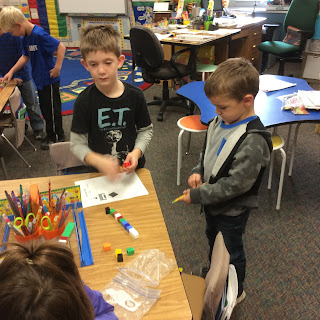After enjoying the story, we used our math vocabulary to complete a measuring activity of our own. Rather than using a ruler with inches, we used linking cubes to make an estimate and then actually measured three classroom items: a chair, a table, and a book. In order to make a sensible estimate, the students collaborated with their partners to think. Will it take more or fewer blocks than the example modeled? Once each partner recorded an estimate, the partners started the actual measuring. After recording the number of blocks, the partners evaluated how they did with their first estimate. Before moving on, they were encouraged to think: Will the number of blocks to measure the chair be greater than or less than the number of blocks to measure the table?
Saturday, November 4, 2017
Measurement
As we were learning about the letter Ii and the short vowel sound, we read and enjoyed the book Inch By Inch by Leo Lionni. Before we read, we predicted what the inchworm would do, and we predicted why the book had this title. During our reading, we revised our predictions as we heard the story. We also used visualization to help us understand the story, making a movie of what we would see, hear, and feel as we were measuring other birds in the wild. We really imagined hearing the nightingale's song as the inchworm measured away until he escaped becoming his dinner.

After enjoying the story, we used our math vocabulary to complete a measuring activity of our own. Rather than using a ruler with inches, we used linking cubes to make an estimate and then actually measured three classroom items: a chair, a table, and a book. In order to make a sensible estimate, the students collaborated with their partners to think. Will it take more or fewer blocks than the example modeled? Once each partner recorded an estimate, the partners started the actual measuring. After recording the number of blocks, the partners evaluated how they did with their first estimate. Before moving on, they were encouraged to think: Will the number of blocks to measure the chair be greater than or less than the number of blocks to measure the table?
After enjoying the story, we used our math vocabulary to complete a measuring activity of our own. Rather than using a ruler with inches, we used linking cubes to make an estimate and then actually measured three classroom items: a chair, a table, and a book. In order to make a sensible estimate, the students collaborated with their partners to think. Will it take more or fewer blocks than the example modeled? Once each partner recorded an estimate, the partners started the actual measuring. After recording the number of blocks, the partners evaluated how they did with their first estimate. Before moving on, they were encouraged to think: Will the number of blocks to measure the chair be greater than or less than the number of blocks to measure the table?






